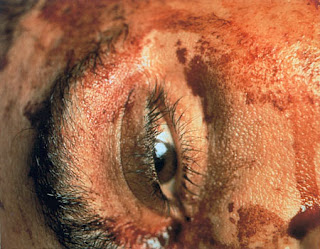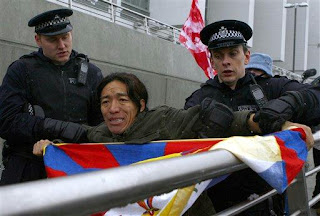Culture: a way of living.
Empire: locations ruled by a single authority.
Dissemination invariably offers multiple translations of events to any one economy of translation. Major media corporations are losing their ability to dictate the means of disseminating information with the increase of digital information sharing. Despite the relative democratizing of the media by digital information sharing, others continue to be silenced by the censorship of dissent, most notably, by China, Iran and Russia via the internet, while still others are silenced by more conventional means. Often, those who silence images and information argue that they fall outside of the so-called “mainstream” or “popular culture.” Such an argument shows ambivalence to cultural difference. Cultural difference seeks to translate the infinite variations of location that otherwise fall outside of “popular culture,” producing partial, autonomous representation.
Cultural difference relatively emancipates media by having the potential to partially represent the indeterminate locations of culture, instead of the One culture signified by the nominal use of the term “popular culture.” The hegemony of so-called “popular culture” is meant to marginalize and stifle those seeking to have partial, autonomous representation.
The modernist epoch sought a full representation of events via dominant media formations. The news—owned by major media corporations— with much uncertainty, came to replace the novel,1 which, according to Mikhail Bakhtin, Russian philosopher, literary critic and semiotician, replaced the epic as a dominant literary form. As such, claims to a fully realized democracy via digital media as print newspapers’ sales and televisions’ ratings decline bare some resemblance to a continuation of modernism’s technocratic project. Yet, that publishing on the internet requires much less initial capital than print publication, television or radio broadcasting does, indeed, make it more affordable for many more locations to disseminate images and information. This has lead to a relative “democratizing” of media. This would not be the case if such media had not led to the regional sharing of images and information otherwise hidden by ambivalent, cultural imperialism. Indeed, that protests against China’s suppression of the autonomous Tibetan region surfaced around the Olympic torch relay in the U.S., U.K., France, and other nations during the 2008 Beijing Olympics shows what is at stake (figs. 1-5). That China attempted to counter such protests with their own pro-Beijing Olympic supporters (and a much larger police presence) shows the nuance of cultural difference.
A popular culture implies a homogeneous, and, therefore, full representation. It implies imitating an authentic “popular” culture associated with empire. There have been efforts to counter cultural imperialism. For instance, Mounir Fatmi’s project to broadcast on a satellite network images collected from immigrants in Val Fourré2 for Ovalproject (figs. 6-7),3 2001-2004, images of car fires, hip-hop, traditional marriages, documentaries, clay, collages and fictional works, attempted to represent the immigrant who ‘has no image’4 (at one point, Fatmi filmed news crews from media corporations filming residents of Val Fourré). No doubt some of the images resemble those seen of the riots in the Parisian suburbs broadcast by major French media corporations. This is the difficulty and task of cultural difference: to survey alterity. For artists, this means abandoning the modernist notion of the autonomous
image.
Cultural difference has taken the attention of postcolonial theory. Gayatri Chakravorty Spivak, literary critic and postcolonial theorist and professor at Columbia University, has used cultural difference to define the task of critical regionalism to answer the question ‘can postcolonialism travel?’ Spivak: “I have emerged into this vast space—where ignorant armies clash, and world governance and international civil society come in to redress the obvious evils of cultural difference” (Spivak, Other Asias, pp. 131). Homi K. Bhabha, postcolonial theorist and professor at Harvard University, uses cultural difference to counter the “ambivalent, unwelcome truth of empire’s lie” (Bhabha, The Location of Culture, pp. 198) by tracing hybrid identities, much in the way of Spivak’s genealogical deconstruction for the purpose of distributing capital equitably amongst individuals. It is because cultural difference requires translation that it has the greatest potential for postcolonialism.
Artists can, potentially, disseminate images necessary for cultural translation. For instance, Robert Mapplethorpe’s photographs (fig. 8) of homoerotic nudes in Robert Mapplethorpe: The Perfect Moment, 1989, represented parts of gay culture when many of its members suffered from H.I.V. and AIDS. This presented an opportunity for others to see images of queer culture at a time when it was becoming a scapegoat for an international health crisis. However, a Republican held majority in the U.S. Congress during the 1990’s cited this exhibition—which received large numbers of visitors—along with funding for projects by Robert Clark Young, Barbara Degenevieve and Andres Serrano (fig. 9), as examples of the National Endowment for the Arts’ (N.E.A.) ‘denigration of U.S. culture,’ by which, no doubt, they meant that of the wealthy, heteronormative, phallocentric, Western and white supremacist, as one of the reasons to cut over one-third of the N.E.A.’s funding and cease all funding directed for individual visual artists’ projects. This is an example of the hegemony exerted by the dominant culture of empire in which cultural difference is suppressed to stop cultural translation. What other projects for cultural translation have been stymied by cultural imperialism? Artists can disseminate images for translation; however, they must smash the major media corporations that represent empire’s ambivalence.
Chance infuses cultural difference; Reason confuses it.
Works Cited
Bhabha, Homi K., The Location of Culture, London and New York: Rutledge Classics, 1994
Fatmi, Mounir, Ovalproject, 2001-2003, Paris: http://www.ovalprojet.com/
Hadria, Michèle Cohen, interview with Mounir Fatmi, “My audience is the person sitting next to me,” Paris: http://www.mounirfatmi.com/5critiques/inter_hadria.html, 2002
Spivak, Gayatri Chakravorty, Other Asias, Malden, MA, Oxford, U.K., Victoria, Australia: Blackwell Publishing, Ltd., 2008












